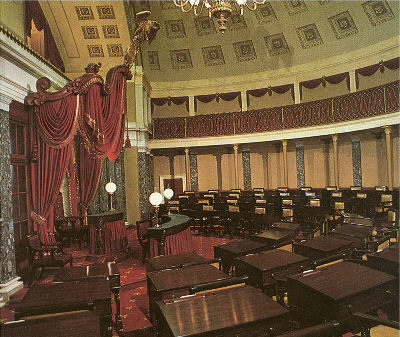 The Old Senate chamber, home of the Webster-Hayne debate
The Old Senate chamber, home of the Webster-Hayne debateMarch 1: Slavery, Union, and the Constitutional Order, I
 The Old Senate chamber, home of the Webster-Hayne debate
The Old Senate chamber, home of the Webster-Hayne debate
| Again, as with last class, do the reading thoroughly, because a lot of what we'll be covering in class on Thursday will deal with material that the reading doesn't address. We'll be getting back to a more integrated approach next week, and will remain the way for the rest of the term. The readiing focuses on the emergence of the Senate as a forum for constitutional debate; class next time will talk about slavery, race, imperialism, and the Constitution. |
READINGS:
secondary
Peterson, The Great Triumvirate (last article in Sourcebook 1) |
| This is an excerpt of a three-faceted biography of the towering figures in the Senate between 1820 and 1850: John Calhoun of South Carolina, Daniel Webster of Massachusetts, and Henry Clay of Kentucky. The reading and the documents focus on the key constitutional issue of the years between 1830 and 1850: the tension between state and federal power, over not only the slavery issue but also territorial and economic policy. |
documents:
| Hayne-Webster debate: outline |
| Daniel Webster's final rebuttal to Hayne, from the Congressional Globe |
| (the speech runs to page 80) |
| tour the America of the day |
STUDY QUESTIONS
1.) What do you see as the most important change in the consideration of federal vs. state rights between the ratification of the Constitution and the Webster/Hayne debate? |
2.) Was slavery the only issue behind the constitutional debate between Webster and Hayne? |
3.) What would an America structured along Hayne's principles have looked like? Along Webster's principles? |